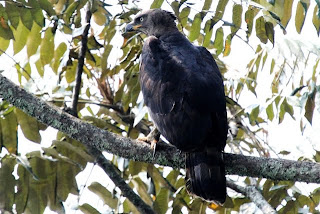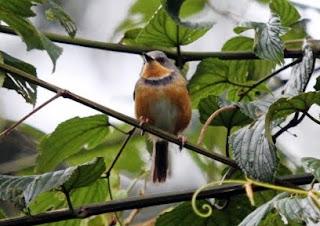Entering the Nyungwe National Park we immediately saw groups of
Olive Baboon by the roadside followed shortly after by a troop of
L'Hoest's Monkey. Nyungwe is the stronghold of this attractive monkey and the only place where they are really common.
Silver Monkey was seen shortly after. This species is now split from the Blue Monkey cluster. We didn't dilly-dally as we were anxious to get to our respective destinations, Jared and Michelle, our travelling companions, to the campground before dark, and Stella and me to the newly built Top View Hotel somewhere in Gisakura west of the park.
 |
| L'Hoest's Monkey |
Next morning (July 2) we were to meet at the campground at 5.30 to go chimp tracking. This required us leaving the hotel no later than 4.45 so we were up around 4. Horrific! I wrote in the last post about the chimp tracking experience and its disappointment not so much in not seeing the chimps as in the fact that we didn't really do any tracking apart from a brief descent down a hillside at the very beginning. I understand the reasoning behind not wanting people to exert themselves unnecessarily if the chimps can't be seen but it kind of defeats the purpose of calling it a tracking experience if you just hang around waiting. Surely a small group at least attempting to follow chimps feeding out of sight is a more anticipatory and thus exciting experience, even if the chimps remained hidden, than waiting for a walkie talkie go ahead. But what do I know? Maybe the terrain was too difficult and they took one look at Stella and me and said - there is no way these old geezers will get down that slope!
 |
| Great Blue Turaco |
On the plus side, going down the slope was also where there was a very large troop (the guide said up to 500) of the
Rwenzori Colobus Monkey, a race of the more widespread Angola Colobus, which is restricted to the Albertine Rift. (Rwenzori precedes the name of many of the Rift endemics and relates to the Rwenzori Mountains in the Ugandan part of the Rift - Ptolemy's Mountains of the Moon and presumed source of the Nile in AD350). These are beautiful looking monkeys, white on the face and arms, although they are marginally less attractive than the Guereza Colobus that we saw in Tanzania with their bushy long white tails. At the top of the slope looking down we also saw our first pair of
Great Blue Turaco perched on top of tall tree. This is an enormous (75cm) and spectacular blue turaco that has a red-tipped yellow bill and a rather floppy black crest. This would be the first of many sightings of this impressive bird.
 |
| Crowned Eagle |
We wandered up and down the path as villagers from the remote community of Banda 12 kilometres away passed us by carrying heavy bags and sometimes house goods on their heads. This track was the only access to the village which is being encouraged to develop eco-tourism opportunities by an American charity. How they will achieve that so far away I don't know. Then we took a fork into one of the circular tracks that spread out from the campground and settled down into some birding while the guide continued to radio about the progress of the chimp troop. Very soon we saw
Crowned Hornbill with their bright red bills and then a huge (74cm)
Black-and-white-casqued Hornbill showed up beautifully in a tree looking down into the valley. Casqued hornbills like this one (and the Silvery-cheeked Hornbill that we saw in Tanzania) are more calculated to produce the back shiver of excitement familiar to hornbill watchers in Asia. Some of the smaller African hornbills, by comparison, are somewhat of a let down to this fine family name.
 |
| Narina Trogan |
Our chimp guide, who admitted to little birding knowledge, suddenly called us to come quickly. There on a branch to the left of the track sat a male
Bar-tailed Trogon with its brilliant red breast, blue upper chest band, black head, green back and long barred tail. There are only three species of trogon found in Africa, the Bare-cheeked in West and Central Africa, plus the Bar-tailed and Narina which are widespread throughout Africa with the Bar-tailed usually at higher altitudes. The Narina is more common and we have seen it on a couple of occasions. Trogons, like hornbills, are species of fantasy. Turacos, which were new to us until Africa, have now joined this select group. At this point another member of the turaco family flew into a nearby tree. It was a
Black-billed Turaco, one of five green turacos found in Africa. All turacos except the Great Blue have red/crimson on the wing which shows extensively in flight. The Black-billed also has a white line on the back of the head and white lines above and below the eye. This is a very shy turaco but I caught a glimpse of its facial white before it disappeared into the canopy. The final morning highlight was the striking
White-headed Wood-hoopoe.
 |
| Collared Apalis |
We had bumped into Narcisse, Nyungwe's best bird guide, with four American birders on the track and arranged to meet back at the campground after lunch to do a trip together in the afternoon. As mentioned in the previous post, it turned out that one of the Americans was top birder David Shackelford who works for Rockjumper the big South African birding company. He was on a personal tour of East Africa with his wife and two friends and he invited us to join them birding. This turned out to be a huge bonus as his knowledge was massive. We went on the Karamba Trail a more open area for birding as it used to be a gold mining site. Here the highlights were
Blue-headed Sunbird, Black-collared Apalis, Purple-breasted Sunbird, Archer's Robin-Chat, Red-faced Woodland Warbler and
Strange Weaver all of which are Albertine Rift Endemics (AREs). The Strange Weaver is a Rift skulker, unusual for a weaver, but it sat up perfectly for us and gave great views of its black head and upper chestnut breast with yellow below. The long-tailed, iridescent, purple-breasted and blue-headed sunbirds also showed up nicely in the afternoon sunshine. Sunbirds really are a treat in Africa. On the winding stretch back up to the hotel two small, white-spotted nightjars froze in the car highlights. Narcisse identified them as the endemic
Rwenzori Nightjar.
 |
| Strange Weaver |
The following morning we set out to climb Bigugu Trail in search of the elusive and rare endemic, the Black-collared Mountain Babbler. Along the way we heard the call of one of the signature birds of Nyungwe - the
Rwenzori Turaco. Patience rewarded all of us with superb views of this truly magnificent looking bird. This medium-sized painted turaco could superficially be accused of overdoing it but its different colours meld superbly together and demand more and more time, seldom given, to examine in greater detail. Stevenson and Fanshawe's Birds of East Africa describes it well. It has "a glossy green-blue crest, orange-yellow lores and eye-ring, blue-black chin and throat, and maroon nape ------- with a rosy-orange blush on the centre of the breast" + the typical, exposed red of the wing in flight.
 |
| Rwenzori Turaco |
We were also fortunate in getting half-decent views of a very shy bird, the
Barred Long-tailed Cuckoo. This higher altitude path had fewer birds than Karamba but still managed great views of the
White-starred Robin and endemic
Rwenzori Batis. Both these charming species from completely different families have little white dots in front of their eyes that face you like miniature headlights. This is a superb walk even without the birds.
 |
| Sharpe's Starling |
We also came across two snakes on the path, one very small and greenie/blue and the other larger (1m) which Narcisse thought was Nyungwe's only venomous snake - a green viper. It was also on this path that we all got excellent views of a
Carruther's Mountain Squirrel. We also were able to observe at length a pair of uncommon and nesting (in a tree hole)
Sharpe's Starling.
We turned back as this track went to the top of Mt Bigugu at nearly 3000m. It was then we heard the call of the sought after
Red-collared Mountain Babbler. It took a long time for everyone to get a look but eventually a pair of the birds were sighted high up in a forest tree clambering around like nuthatches in search of grubs. Even from a fair distance we could make out the bird's white eyes as well as its distinctive black cap and cinnamon collar.
 |
| Northern Brown-throated Weaver |
The Sunday afternoon trip was to Kamiranzovu Swamp. This means 'elephant swallowing' as in the past elephants reputedly got stuck and perished when attempting to cross the marshy area. The last elephant in the park, however, was not sucked into the ground but blasted by poachers as recently as 1999. The target bird for the trip was another rare endemic -
Grauer's Rush Warbler (Bradypterus graueri) in its reedy habitat. On the way down we saw another Grauer -
Grauer's Warbler (Graueria vittata). Playback helped in calling the rush warbler out and we all got brief views. We then tried to see a
Red-chested Flufftail, a secretive kind of rail, but, although the bird was only about a foot away or so, it would not show itself. This is a circular walk and we proceeded back along the valley and up the hill by a different direction. This section was turaco heaven with Great Blue and Black-billed crossing back and forth in front of us. The Great Blue once again gave us splendid views. We saw movement over to the right and, finally, got fantastic views of another key bird of the Nyungwe area - the
Regal Sunbird. Even by sunbird standards this one is a little bit special with its bright yellow breast on either side of a brilliant red bar running vertically down the centre. Climbing back up to the road we almost stood on a species of legless lizard. We attempted to locate the rare
Albertine Owlet at dusk but without success. We did, however, get great views of the endemic
Handsome Francolin as it was settling down at its evening roost.
 |
| Verreaux's (Giant) Eagle-Owl |
Our final morning was a walk near Gisakura with forest on one side and tea plantation on the other. Highlights here were
Lesser Honeyguide, African Green Pigeon, White-chinned Prinia and, especially, the
Brown-throated Wattle-eye with its brilliant red wattle right above the eye. Back at the campground to pick up Jared and Michelle we spotted our final endemic of the trip -
Stripe-breasted Tit. We missed three expected endemics -
Yellow-eyed Black Flycatcher, Red-throated Alethe (which were surprisingly absent) and
Dusky Crimsonwing (which we heard only). Nyungwe certainly needs more than a two and a half day stay to unlock most of its key secrets. It is a tough place to see wildlife, as all rainforests are, but now that I have a feel for it, I would love to go back.
(All photos except L'Hoest's Monkey and Narina Trogon were taken by Steve Zee)





